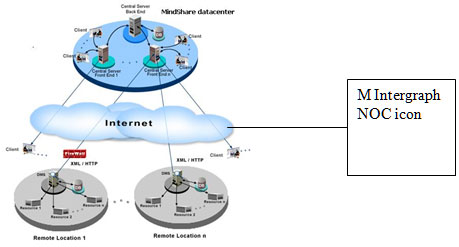Resource Library
Resources Library:Delivery
Enterprise monitoring architecture:
MindShare’s Network Operations Center uses sophisticated enterprise monitoring and management tools to help create efficient, proactive IT support and keep our customers network resources up and running.
Our tools architecture consists of a central datacenter center installed at our central site, communicating with either customer on-premise equipment (usually a rack mountable computer) or an agent, depending on the client environment and service levels.
The client sites communicate to M Intergraph datacenter using SOAP/XML through HTTP/HTTPS. M Intergraph installs the customer premise equipment or the agent at each of the client locations. A virtual service center is created for each client and the services are delivered to the client from the M Intergraph Network Operations Centre (NOC). An interface is provided with our monitoring tool into the ticketing system for automated ticket generation for all proactive tickets, there by increasing NOC efficiency.
MindShare’s Network Operations Center uses sophisticated enterprise monitoring and management tools to help create efficient, proactive IT support and keep our customers network resources up and running.
Our tools architecture consists of a central datacenter center installed at our central site, communicating with either customer on-premise equipment (usually a rack mountable computer) or an agent, depending on the client environment and service levels.
Monitoring
Enterprise monitoring architecture:
Monitors all IP based devices at a customer’s site based on industry based best-practice monitoring policies Monitoring of all critical network components such as workstations, servers, applications, websites, network services, (i.e. firewalls and routers) are all available through industry based standards and protocols (WMI, SNMP, Syslog, NetBios, ICMP, XML, etc) used widely within a typical network environment.
Alerting
Robust notification engine to keep system engineers informed when problems are identified in an environment. The alerting engine is closely tied to monitoring engine. Based on the monitoring being performed you can define search strings, thresholds, events or many other parameters with alerts sent to any user or external individual. Alerts themselves can take many forms including trouble ticket creation, email and can be scheduled to ensure that appropriate people are being notified.
Remote Control
Remote Control to any Windows, MAC OSX, Linux and Unix device residing within any customer’s site.
Patch Management
Fast and reliable patching capabilities on servers and workstations to help you proactively defend against network threats and outdated software versions.
Scripting
Remote Scripting provides flexible remote management capabilities. It allows users to deploy a variety of scripts for maintenance, repair, installation or any task base script.
Policy Modules (Templates)
Best-practice management policy modules (templates) for easy, fast, and standardized monitoring of all most-commonly used devices on a customer network.





